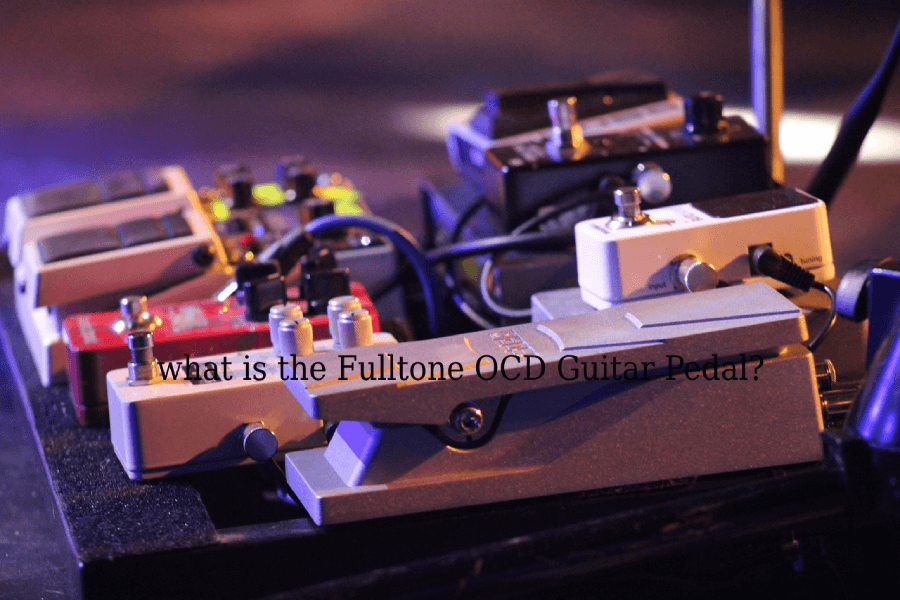If you’ve been strumming those strings for a while, chances are you’ve heard the whispers about this legendary stompbox. Its reputation among guitarists is nothing short of iconic. In this article, we’ll delve into the mystique of the Fulltone OCD pedal, from its humble beginnings to its status as a must-have for every serious guitarist.
The History of Fulltone and the Origins of the OCD
To truly understand the Fulltone OCD pedal, we need to rewind to its roots. The story begins with Fulltone, a company founded by Michael Fuller, a man on a mission. Fuller’s vision was clear: to craft guitar pedals that didn’t just replicate vintage tones but elevated them to new heights. His dedication to quality and passion for music led to the birth of Fulltone in 1991.
Now, let’s talk about the inspiration behind the OCD pedal. As the legend goes, Fuller was on a quest for the elusive tone, that magical sound that resonates deep within the soul of a guitarist. His relentless pursuit led him to create the Obsessive Compulsive Drive (OCD) pedal. Inspired by classic overdrive tones, this pedal was engineered to capture the essence of a cranked tube amp, offering guitarists an unmatched tonal experience.
The Evolution of the OCD Pedal
Like any masterpiece, the Fulltone OCD pedal has undergone an evolution since its inception. It started as a humble overdrive pedal but quickly gained a following for its distinct character. Over the years, Fulltone made significant revisions and improvements to keep the OCD at the cutting edge of guitar technology.
The OCD pedal’s journey saw it go through various versions, each refining and enhancing its sonic capabilities. Musicians worldwide embraced these improvements, making the OCD a staple on countless pedalboards. It wasn’t just an effect pedal; it was a sonic revolution (and it was so popular that there still are countless guitar pedals that are Fulltone OCD Overdrive pedal clones in the electric guitar world).
Key Features of the Fulltone OCD Pedal
The Fulltone OCD pedal isn’t just another box of knobs and switches; it’s a finely tuned instrument in its own right. Let’s dive into the features that make this pedal a guitarist’s dream:
1. Volume Knob:
The Volume control might seem self-explanatory, but it’s a vital part of the OCD’s magic. Crank it up for a boost in output, or dial it back for subtle nuances in your tone.
2. Drive Control:
The Drive knob is where the magic truly happens. It determines how much gain and overdrive you want. Twist it clockwise for a gritty, saturated sound or keep it lower for a cleaner boost.
3. Tone Control:
The Tone knob acts as your tonal sculptor. Turn it to the right for brighter tones with more bite or to the left for a warmer, rounder sound. It’s all about finding that sweet spot that suits your style.
4. HP/LP Switch:
The High Peak (HP) and Low Peak (LP) switch offers a distinct choice in EQ shaping. HP provides a more pronounced midrange, perfect for cutting through the mix, while LP gives you a smoother, bass-heavy response.
5. True Bypass:
The OCD features true bypass switching, ensuring that when it’s turned off, your signal remains unaltered. This preserves your guitar’s natural tone when the pedal isn’t in use.
Now, let’s talk about how these controls impact your tone and versatility. With the OCD, you have a palette of tones at your fingertips, from clean and transparent to searing overdrive. It’s not just an overdrive pedal; it’s a tone-shaping tool that allows you to sculpt your sound with precision.
So, where does the Fulltone OCD pedal fit in the real world of music? It’s not just for bedroom heroes; it’s a staple on professional stages and in studio rigs. Artists across genres turn to the OCD for its reliability, versatility, and that unmistakable tone.
From blues legends to hard rock icons, the OCD has found its way onto pedalboards worldwide. Whether you’re chasing classic rock tones or pushing the boundaries of modern music, the Fulltone OCD pedal is your trusty companion.
In the next installment, we’ll explore the real-world applications in more detail, showcasing how guitarists from different backgrounds and genres harness the power of the OCD to craft their signature sound. Stay tuned for more inspiration and insights into this extraordinary pedal.
The Fulltone OCD pedal has carved a prominent place in the world of professional guitarists. Let’s take a look at some famous guitarists who swear by this iconic stompbox and explore how it has been utilized across different music genres.
Famous OCD Users:
1. Keith Urban:
- The country superstar is known for his pristine tone, and the OCD plays a pivotal role in his rig. It provides that extra layer of grit and sustain, making his solos soar.
2. Eddie Vedder (Pearl Jam):
- Eddie Vedder’s passionate live performances wouldn’t be the same without the OCD. It adds a layer of warmth to his sound, enhancing the emotional depth of Pearl Jam’s music.
3. Joey Santiago (Pixies):
- The Pixies’ Joey Santiago is a true pioneer of alternative rock. He relies on the OCD to achieve those unpredictable, screeching feedback sounds that define the band’s sound.
4. Gary Clark Jr.:
- The modern blues virtuoso uses the OCD to infuse his blues-rock with just the right amount of edge. It’s a secret weapon in his arsenal for searing solos.
Across Different Genres:
The Fulltone OCD pedal’s versatility is evident in its adoption across various music genres:
- Blues: In the blues world, it’s appreciated for its ability to add character and bite to classic blues tones.
- Rock: For rock guitarists, it’s a workhorse that can go from smooth overdrive to roaring distortion with ease.
- Indie/Alternative: Indie and alternative bands find the OCD’s ability to push the boundaries of feedback and sustain particularly intriguing.
- Country: In country music, it’s used to add a touch of dirt to pristine clean tones, providing the perfect blend of twang and attitude.
Tips and Tricks for Getting the Most from Your OCD
Optimizing your Fulltone OCD pedal for your desired tone is essential. Here are some practical tips and settings for popular tones and effects:
- Classic Overdrive: Set the Drive knob around 9 o’clock for a mild breakup, the Volume to taste, and the Tone knob around noon for a balanced tone.
- Blues Lead: Crank up the Drive to 3 o’clock, set the Volume for a slight boost, and adjust the Tone to your preference. This setting adds grit while retaining clarity.
- Rock Crunch: Max out the Drive for high gain, adjust the Volume for your desired level, and fine-tune the Tone for cutting through the mix.
- Clean Boost: For a transparent clean boost, set the Drive low, crank the Volume, and adjust the Tone knob slightly to shape the sound.
Common FAQs About the OCD Pedal
Let’s address some common questions and concerns about the Fulltone OCD pedal:
Q1: Is the Fulltone OCD pedal true bypass? Yes, the OCD pedal features true bypass switching to preserve your guitar’s natural tone when it’s turned off.
Q2: Can the OCD be powered by a battery? Yes, it can be powered by a 9V battery or a standard 9V power supply.
Q3: Does the OCD work well with single-coil pickups? Absolutely, the OCD is versatile and pairs well with both single-coil and humbucker pickups.
Comparing OCD Versions and Clones
While the original Fulltone OCD remains a classic, there are various versions and clones available. Let’s briefly touch on them and highlight the differences:
- Fulltone OCD V2: This version introduced a switch for selecting between buffered bypass and true bypass, offering more options for your signal chain.
- OCD Clones: Several companies have produced clones of the OCD pedal, aiming to replicate its iconic sound at a lower price point. While these clones can be great alternatives, the original Fulltone OCD retains its status as a benchmark in overdrive pedals.
CONCLUSION
In the realm of guitar pedals, where the pursuit of tone is a lifelong journey, the Fulltone OCD pedal stands as an enduring beacon of excellence. Its rich history, celebrated sound, and versatility have earned it a place of honor on countless pedalboards around the world.
The Fulltone OCD pedal isn’t just a piece of gear; it’s a sonic companion, a trusted ally in the quest for the perfect tone. From blues to rock, from country to alternative, it effortlessly traverses genres, breathing life into every note and chord.
As a seasoned guitarist or an aspiring musician, exploring the world of the Fulltone OCD pedal is a sonic adventure waiting to unfold. Whether you’re seeking searing leads, creamy overdrive, or a transparent clean boost, the OCD has you covered.
So, dear reader, don’t miss the opportunity to experience the magic of this iconic pedal for yourself. Plug in, twist those knobs, and embark on a journey of sonic discovery. The Fulltone OCD pedal is more than just a tool; it’s an invitation to unlock your full creative potential and craft your signature sound. Join the ranks of legendary guitarists who have harnessed its power, and let your music soar to new heights.

